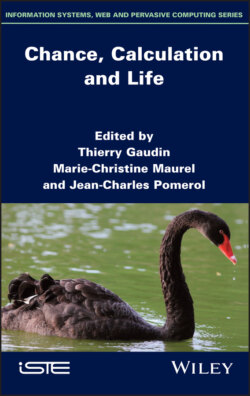Читать книгу Chance, Calculation and Life - Группа авторов - Страница 16
1.2. Randomness in classical dynamics
ОглавлениеA major contribution to the contemporary understanding of randomness was given by Poincaré. By his “negative result” (his words) on the Three Body Problem (1892, relatively simple deterministic dynamics, see below), he proved that minor fluctuations or perturbations below the best possible measurement may manifest in a measurable, yet unpredictable consequence: “we then have a random phenomenon” (Poincaré 1902). This started the analysis of deterministic chaos, as his description of the phase-space trajectory derived from a nonlinear system is the first description of chaotic dynamics (Bros and Iagolnitzer 1973).
Poincaré’s analysis is grounded in a mathematical “tour de force”. He proved the non-analyticity of the (apparently) simple system of nonlinear equations describing two planets and a Sun in their gravitational fields (three bodies). The planets disturb each other’s trajectories and this gives the formal divergence of the Lindstedt-Fourier series meant to give a linear approximation of the solution of the equations. More precisely, by using his notions of bifurcations and homoclinic orbit (the intersection of a stable and an unstable manifold), he showed that the “small divisors”, which make the series diverge, physically mean that an undetectable fluctuation or perturbation may be amplified to a measurable quantity by the choice of a branch, or another in a bifurcation, or a manifold along a homoclinic orbit. It is often difficult to give a physical meaning to the solution of a system of equations; it is particularly hard and inventive to make sense of the absence of a solution. Yet, this made us understand randomness as deterministic unpredictability and non-analyticity as a strong form of classical unpredictability2.
In this classical framework, a random event has a cause, yet this cause is below measurement. Thus, Curie’s principle3 is preserved: “the asymmetries of the consequences are already present in the causes” or “symmetries are preserved” – the asymmetries in the causes are just hidden.
For decades, Poincaré’s approach was quoted and developed by only a few, that is, until Kolmogorov’s work in the late 1950s and Lorentz in the 1960s. Turing is one of these few: he based his seminal paper on morphogenesis (Turing 1952) on the nonlinear dynamics of forms generated by chemical reactants. His “action/reaction/diffusion system” produced different forms by spontaneous symmetry breaking. An early hint of these ideas is given by him in Turing (1950, p. 440): “The displacement of a single electron by a billionth of a centimetre at one moment might make the difference between a man being killed by an avalanche a year later, or escaping”. This Poincarian remark by Turing preceded by the famous “Lorentz butterfly effect” (proposed in 1972) by 20 years on the grounds of Lorentz’s work from 1961.
Once more, many like to call this form of classical randomness “epistemic” unpredictability, that is related to our knowledge of the world. We do not deal with ontologies here, although this name may be fair, with the distinction from the understanding of randomness as a very weak form of unpredictability proposed by Spinoza. Poincaré brought a fact known since Galileo into the limelight: classical measurement is an interval, by principle4. Measurement is the only form of access we have to the physical world, while no principle forbids, a priori, to join two independent Spinozian dynamics. That is, even epistemic, classical physics posits this limit to access and knowledge as a priori measurement. Then this lack of complete knowledge yields classical randomness, typically in relation to a nonlinear mathematical modeling, which produces either positive Lyapunov exponents or, more strongly, non-analyticity. In other words, classical systems (as well as relativistic ones) are deterministic, yet they may be unpredictable, in the sense that randomness is not in the world nor it is just in the eyes of the beholder, but it pops out at the interface between us and the world by theory and measurement.
By “theory” we mean the equational or functional determination, possibly by a nonlinear system of equations or evolution functions.
